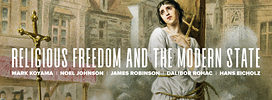We appreciate Hans Eicholz’s further comments on our essay. His conclusion is that we should look to European cities as the source of liberal tendencies in medieval and early modern Europe.
This is a venerable argument that goes back to Max Weber and Henri Pirenne, and indeed to Adam Smith. Cities were incubators of civil republicanism, market liberalism, and greater religious freedom.
There is much to this argument. Certainly, we agree that the Italian city-states in particular provided governance models that later states imitated. They developed republican political institutions and built fiscal capacity. Sovereign debt markets first developed in late medieval Italian cities were only adopted by larger states in the 17th and 18th centuries. Cities also offered freedom to serfs.[1] But it is important to point out that recent research cautions against viewing Europe’s independent cities as forebears of modern liberalism.
Stephan R. Epstein’s important work Freedom and Growth pointed out that city-states such as Florence were far from liberal in how they treated their rural hinterlands.[2] Contrary to their reputation, princely states were often less rapacious or extractive.
In the late Middle Ages, Florence imposed protective tariffs and restrictions on the products of its local rivals, Pistoia and Prato. Epstein documents how powerful cities like Florence had a detrimental impact on rural proto-industrialization. In Epstein’s view,
Up to the 1450s Florentine policy towards the contado combined paternalistic and authoritarian norms established in the early fourteenth century, including rural export bans and forcible supplies at fixed prices to the city, the forced distribution of grain imports and excess stocks among the peasantry, and loans to stimulate agricultural recovery (Epstein, 2000, 161).
Recent work by Sheilagh Ogilvie also casts shade on the pro-market reputation of medieval city-states. Medieval cities were dominated by craft and merchant guilds that established barriers to entry and regulated trade. Ogilvie notes that medieval cities were less open than is often supposed:
Few towns admitted outsiders freely to the full economic rights of ‘citizens’ status.’ They placed conditions on citizenship and, as a consequence, excluded people who could not fulfill the requirements. Towns often charged citizenship admission fees to raise revenue, something they were able to do because citizenship meant access to a pool of profitable privileges which only urban citizens enjoyed, among them the right to apply for guild membership (Ogilvie, 2019, 97).
This research cautions against a reading of European history which posits “liberal” cities against “autocratic” states. Medieval city states did cultivate Republican notions of civic virtue and autonomy and were important centers of long-distance trade and manufacturing. But sustained economic growth required access to larger markets than any single city-state could provide. The economic rise of Western Europe certainly cannot be understood without recognizing the legacy of the independent cities of the Middle Ages, but it also can’t be fully appreciated without recognizing the important contribution of nation-states and larger federations, such as 19th-century Zollverein.
Notes
[1] It is less clear whether medieval cities offered meaningful bastions against religious persecution.
[2] S.R. Epstein, (2000). Freedom and Growth. Routledge: London.

